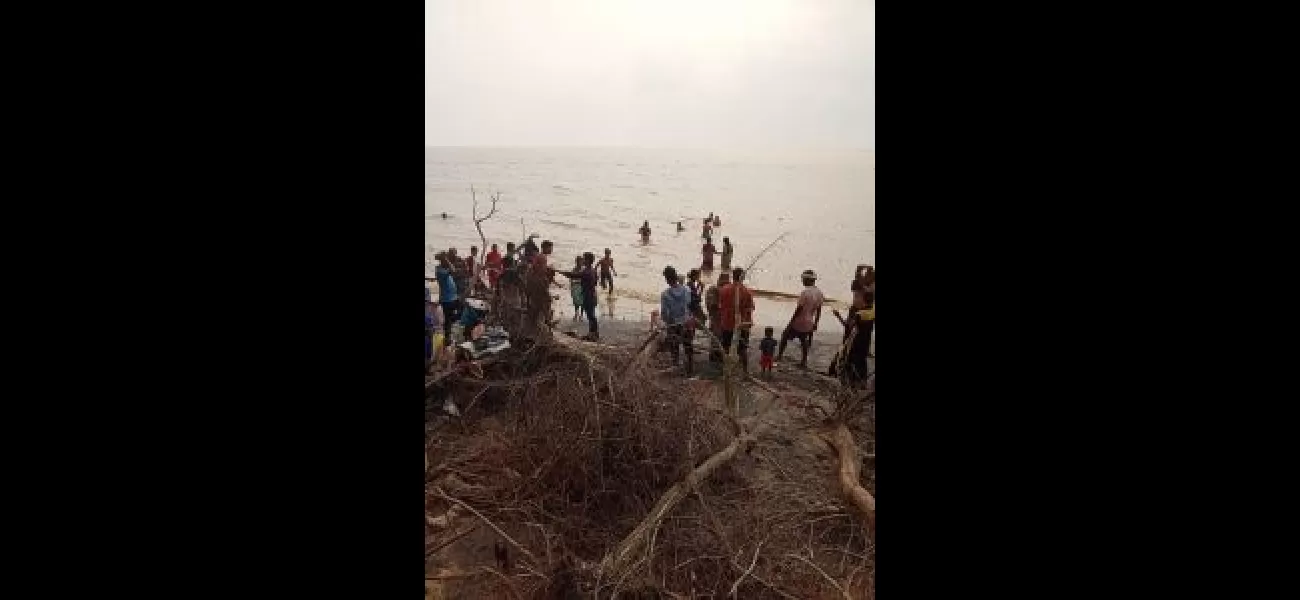Kendrapara suffers from severe damage caused by erosion along the coast.
People have always lived near water for trade, food, and fun. But climate change is eroding coastlines and harming those who live there.
June 17th 2024.

For centuries, people have been drawn to the shores, building their homes and lives close to major waterways. The proximity to trade opportunities, seafood, and leisure activities made it an ideal location. However, with the constant changes in our environment, these once malleable geological structures are now being chipped away. This has caused great distress to the residents living near the coastlines, as they are losing their homes and livelihoods.
One such place where this phenomenon is evident is in the seaside villages of Kendrapara district. The rise in tidal waves and continuous erosion of the coastline has wreaked havoc on the lives and properties of the residents. Reports suggest that out of the total 48 km coastline of the Bay of Bengal in Kendrapara district, 28 km are facing serious threats of erosion. The frequent ingress of tidal waves into these villages has caused significant damage. In fact, just recently, on June 6, during the Sabitri Amavasya celebration, tidal waves crossed the coastline and flooded the seaside village of Tanda in Mahakalapara block. This has sparked an unprecedented fear among the inhabitants of all seaside villages in the district.
The situation is no different in the sea-ravaged Satabhaya panchayat, under Rajnagar block. In just one year, tidal waves have devoured around 40 meters of the coastline. The ancient Panchubarahi temple and Barahipur village in the panchayat are now at risk of being consumed by the sea during this rainy season. The constant coastal erosion has also put the SuneiTupei jungle in danger, threatening to wipe out its green cover.
Experts have warned that urgent measures need to be taken to address this issue. The creation of more mangrove forests on the remaining land in Satabhaya panchayat is seen as the only solution to prevent tidal waves from entering the seaside villages and eroding the land. Sudarshan Swain, a resident of Barahipur village, shared that in the last five decades, seven revenue villages have been swallowed by the sea, while others are slowly moving towards extinction. This has forced the inhabitants to relocate to Bagapatia, after four years of struggle.
Environmentalists have also raised their concerns, with Hemant Kumar Rout suggesting the conversion of the remaining farmland in Satabhaya into mangrove forests. He pointed out that the geo-synthetic tube wall, which was constructed along the Pentha coast by the government, has failed to withstand the rising tidal waves. The gabion boxes filled with huge stones have been washed away, and even the stone embankment is facing the wrath of the waves. The increasing water level in the sea, due to climate change and global warming, has also contributed to this issue. The need for more mangrove forests to act as a shield against the tidal waves is crucial, according to Rout.
However, there is a major obstacle in creating these mangrove forests – the lack of freshwater. Mangroves require at least 40% freshwater, but during the summer season, only 15% reaches the wetland. Social activist Pramila Mallick from Rajnagar highlights the impact of this on the Agarnasi island, which used to be a 7km long shield for the Tanda area. Unfortunately, the island has been washed away into the sea since 2022, leaving areas like Tanda, Suniti, and Babar panchayats exposed to the threat of tidal waves. The residents are now living in constant fear, especially during full moon days, new moon days, and cyclonic storms.
When approached, Forest Ranger Pradosh Moharana assured that efforts are being made to create more mangrove forests along the coastlines. Mangrove saplings have already been planted in Satabhaya and Pentha coasts, and experts have been consulted for further advice on addressing the issue of coastal erosion.
One such place where this phenomenon is evident is in the seaside villages of Kendrapara district. The rise in tidal waves and continuous erosion of the coastline has wreaked havoc on the lives and properties of the residents. Reports suggest that out of the total 48 km coastline of the Bay of Bengal in Kendrapara district, 28 km are facing serious threats of erosion. The frequent ingress of tidal waves into these villages has caused significant damage. In fact, just recently, on June 6, during the Sabitri Amavasya celebration, tidal waves crossed the coastline and flooded the seaside village of Tanda in Mahakalapara block. This has sparked an unprecedented fear among the inhabitants of all seaside villages in the district.
The situation is no different in the sea-ravaged Satabhaya panchayat, under Rajnagar block. In just one year, tidal waves have devoured around 40 meters of the coastline. The ancient Panchubarahi temple and Barahipur village in the panchayat are now at risk of being consumed by the sea during this rainy season. The constant coastal erosion has also put the SuneiTupei jungle in danger, threatening to wipe out its green cover.
Experts have warned that urgent measures need to be taken to address this issue. The creation of more mangrove forests on the remaining land in Satabhaya panchayat is seen as the only solution to prevent tidal waves from entering the seaside villages and eroding the land. Sudarshan Swain, a resident of Barahipur village, shared that in the last five decades, seven revenue villages have been swallowed by the sea, while others are slowly moving towards extinction. This has forced the inhabitants to relocate to Bagapatia, after four years of struggle.
Environmentalists have also raised their concerns, with Hemant Kumar Rout suggesting the conversion of the remaining farmland in Satabhaya into mangrove forests. He pointed out that the geo-synthetic tube wall, which was constructed along the Pentha coast by the government, has failed to withstand the rising tidal waves. The gabion boxes filled with huge stones have been washed away, and even the stone embankment is facing the wrath of the waves. The increasing water level in the sea, due to climate change and global warming, has also contributed to this issue. The need for more mangrove forests to act as a shield against the tidal waves is crucial, according to Rout.
However, there is a major obstacle in creating these mangrove forests – the lack of freshwater. Mangroves require at least 40% freshwater, but during the summer season, only 15% reaches the wetland. Social activist Pramila Mallick from Rajnagar highlights the impact of this on the Agarnasi island, which used to be a 7km long shield for the Tanda area. Unfortunately, the island has been washed away into the sea since 2022, leaving areas like Tanda, Suniti, and Babar panchayats exposed to the threat of tidal waves. The residents are now living in constant fear, especially during full moon days, new moon days, and cyclonic storms.
When approached, Forest Ranger Pradosh Moharana assured that efforts are being made to create more mangrove forests along the coastlines. Mangrove saplings have already been planted in Satabhaya and Pentha coasts, and experts have been consulted for further advice on addressing the issue of coastal erosion.
[This article has been trending online recently and has been generated with AI. Your feed is customized.]
[Generative AI is experimental.]
0
0
Submit Comment





